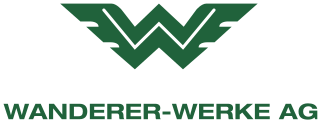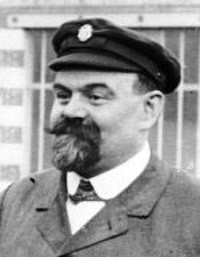
Carl Friedrich Benz, also Karl Friedrich Benz with the same pronunciation, was a German engine designer and automotive engineer. His Benz Patent Motorcar from 1885 is considered the first practical modern automobile and first car put into series production. He received a patent for the motorcar in 1886.

Panhard was a French motor vehicle manufacturer that began as one of the first makers of automobiles. It was a manufacturer of light tactical and military vehicles. Its final incarnation, now owned by Renault Trucks Defense, was formed by the acquisition of Panhard by Auverland in 2005, and then by Renault in 2012. In 2018 Renault Trucks Defense, ACMAT and Panhard combined under a single brand, Arquus.

L'Aster, Aster, Ateliers de Construction Mecanique l'Aster, was a French manufacturer of automobiles and the leading supplier of engines to other manufacturers from the late 1890s until circa 1910/12. Although primarily known as an engine mass manufacturer the company also produced chassis for coach-works and a complete range of components.

Wanderer was a German manufacturer of bicycles, motorcycles, automobiles, vans and other machinery. Established as Winklhofer & Jaenicke in 1896 by Johann Baptist Winklhofer and Richard Adolf Jaenicke, the company used the Wanderer brand name from 1911, making civilian automobiles until 1941 and military vehicles until 1945. Today the brand is part of the Zweirad Einkaufs Genossenschaft (ZEG).

De Dion-Bouton was a French automobile manufacturer and railcar manufacturer operating from 1883 to 1953. The company was founded by the Marquis Jules-Albert de Dion, Georges Bouton, and Bouton's brother-in-law Charles Trépardoux.

Singer Motors Limited was a British motor vehicle manufacturing business, originally a bicycle manufacturer founded as Singer & Co by George Singer, in 1874 in Coventry, England. Singer & Co's bicycle manufacture continued. From 1901 George Singer's Singer Motor Co made cars and commercial vehicles.

Development of the automobile started in 1672 with the invention of the first steam-powered vehicle, which led to the creation of the first steam-powered automobile capable of human transportation, built by Nicolas-Joseph Cugnot in 1769. Inventors began to branch out at the start of the 19th century, creating the de Rivas engine, one of the first internal combustion engines, and an early electric motor. Samuel Brown later tested the first industrially applied internal combustion engine in 1826.

Established in 1901, Belsize Motors was based in Clayton, Manchester, England. The company was founded by Marshall & Company and took its name from their Belsize works, where they had built bicycles.

The Swift Motor Company made Swift Cars in Coventry, England from 1900 until 1931. It grew progressively from James Starley's Coventry Sewing Machine Company, via bicycle and motorised cycle manufacture. The cars ranged from a single-cylinder car in 1900 using an MMC engine, through a Swift-engined twin-cylinder 7-horsepower light car in 1904, and a 3-litre model in 1913. After the First World War a successful range was sold during the 1920s, but the Cadet of 1930 was its last vehicle as it could not compete economically with volume manufacturers such as Ford and Morris Motors.

Daimler-Motoren-Gesellschaft was a German engineering company and later automobile manufacturer, in operation from 1890 until 1926. Founded by Gottlieb Daimler (1834–1900) and Wilhelm Maybach (1846–1929), it was based first in Cannstatt. Daimler died in 1900, and their business moved in 1903 to Stuttgart-Untertürkheim after the original factory was destroyed by fire, and again to Berlin in 1922. Other factories were located in Marienfelde and Sindelfingen.

Léon Bollée Automobiles was a French company founded by Léon Bollée in Le Mans to build a first vehicle called "Voiturette".

The Star Motor Company was a British car and commercial vehicle maker based in Wolverhampton and active from 1898 to 1932. At its peak Star was the UK's sixth largest car manufacturer and produced around 1000 cars a year.

Lorraine-Dietrich was a French automobile and aircraft engine manufacturer from 1896 until 1935, created when railway locomotive manufacturer Société Lorraine des Anciens Etablissements de Dietrich et Cie de Lunéville branched into the manufacture of automobiles. The Franco-Prussian War divided the company's manufacturing capacity, one plant in Niederbronn-les-Bains, Alsace, the other in Lunéville, Lorraine.

Léon Bollée was a French automobile manufacturer and inventor.
France was a pioneer in the automotive industry and is the 11th-largest automobile manufacturer in the world by 2015 unit production and the third-largest in Europe. It had consistently been the 4th-largest from the end of World War II up to 2000. It is 16 % of sales of French manufactured products.
The Paris–Marseille–Paris race was the first competitive 'city to city' motor race originating in Paris, where the first car across the line was the winner, prior events having selected the winner by various forms of classification and judging. The race was won by Émile Mayade who completed the ten-day, 1,710 km, event over unsurfaced roads in 67 hours driving a Panhard et Levassor.

Société Parisienne was a French manufacturer of velocipedes, bicycles and tricycles from 1876. They began limited automobile construction in 1894 and regular light car (voiturette) construction in 1898 or 1899, and they ceased operation in 1903. The vehicles, variously known as Parisienne, Victoria Combination, Eureka, l'Eclair, Duc-Spider and Duc-Tonneau, were manufactured by Société Parisienne E. Couturier et Cie of Paris.
Automobiles Stabilia was an automobile manufacturer based on the north side of Paris between 1906 and 1930. Although the name of the company changed a couple of times, the cars were branded with the Stabilia name throughout this period. The company specialised in lowered cars featuring a special patented type of suspension.

Automobiles Darracq France was a manufacturer of motor vehicles and aero engines in Suresnes, near Paris. The enterprise, known at first as A Darracq et Cie, was founded in 1896 by successful businessman Alexandre Darracq.





















